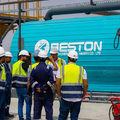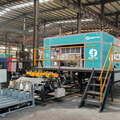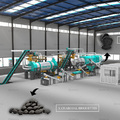In the realm of waste management and sustainable practices, continuous pyrolysis has emerged as a cutting-edge technology with the potential to revolutionize how we handle various types of waste. This process, known as continuous pyrolysis, offers an efficient and environmentally friendly method for converting diverse feedstocks, such as plastics, tires, and biomass, into valuable resources. In this comprehensive exploration, we will delve into the intricacies of the continuous pyrolysis equipment, its applications, environmental benefits, and the role it plays in fostering a circular economy.

Understanding Pyrolysis
Before delving into continuous pyrolysis, it's essential to grasp the fundamental concept of pyrolysis. Pyrolysis is a thermal decomposition process that involves heating organic or carbonaceous materials in the absence of oxygen. The absence of oxygen is critical, as it prevents combustion and allows the material to break down into volatile components without burning.
During pyrolysis, the organic material undergoes a series of chemical reactions, leading to the production of gases, liquids, and char. These resulting products can be utilized for various applications, including the generation of biofuels, recovery of valuable chemicals, and the creation of biochar for agricultural purposes.
Continuous vs. Batch Pyrolysis
Pyrolysis can be carried out in either a batch or continuous process. In batch pyrolysis, a finite amount of feedstock is loaded into a reactor, processed, and then the system is cooled down for the removal of char and the introduction of new material. This process is cyclical and time-consuming, making it less efficient for large-scale operations.
On the other hand, continuous pyrolysis operates as a continuous and uninterrupted process. It involves a continuous feeding mechanism for the input of waste material and a simultaneous removal of the pyrolysis products. This continuous flow system not only enhances efficiency but also allows for a more consistent and stable production output. The continuous nature of the process enables it to handle a continuous stream of waste, making it suitable for industrial-scale applications.
The Continuous Pyrolysis Process
Continuous pyrolysis involves a series of integrated steps to efficiently convert feedstock into valuable products. The process typically includes the following stages:
Feedstock Preparation: The initial step involves preparing the feedstock for pyrolysis. Depending on the type of waste being processed—whether plastics, tires, or biomass—it may undergo shredding or sizing to achieve uniform particle sizes suitable for the reactor.
Continuous Feeding System: Unlike batch pyrolysis, which involves intermittent loading, continuous pyrolysis incorporates a continuous feeding system. This mechanism allows for a constant flow of feedstock into the pyrolysis reactor, ensuring a steady and uninterrupted process.
Pyrolysis Reactor: The heart of the continuous pyrolysis system is the reactor, where the thermal decomposition of the feedstock takes place in the absence of oxygen. The reactor is designed to withstand high temperatures and maintain optimal conditions for the pyrolysis reactions.
Heat Transfer and Control: Continuous pyrolysis systems employ advanced heat transfer mechanisms to ensure efficient and uniform heating of the feedstock. Control systems monitor and regulate temperature, residence time, and other parameters to optimize the pyrolysis process.
Product Collection and Separation: As the feedstock undergoes pyrolysis, it produces gases, liquids, and char. Continuous systems facilitate the simultaneous removal of these products, allowing for efficient separation. Gases may be directed to a gas collection system, liquids to a condensation unit, and char to a collection chamber.
Gas Cleaning and Treatment: The gases generated during pyrolysis often contain impurities and pollutants. Continuous pyrolysis systems typically incorporate gas cleaning and treatment units to remove contaminants, making the resulting gases suitable for various applications, including energy generation.
Product Utilization: The final products obtained from continuous pyrolysis—such as syngas, bio-oil, and biochar—have diverse applications. Syngas can be used for energy production, bio-oil can serve as a precursor for biofuels or specialty chemicals, and biochar can enhance soil fertility in agriculture.
Environmental Benefits
Continuous pyrolysis offers several environmental benefits that make it an attractive technology for sustainable waste management:
Reduced Greenhouse Gas Emissions: By converting organic waste into valuable products such as biochar and bio-oil, continuous pyrolysis mitigates the need for traditional disposal methods like incineration or landfilling. This, in turn, reduces greenhouse gas emissions associated with these conventional waste disposal practices.

Resource Recovery: Continuous pyrolysis allows for the recovery of valuable resources from waste streams. The conversion of biomass, plastics, or tires into useful products contributes to a circular economy, minimizing the reliance on virgin resources and reducing overall environmental impact.
Minimized Landfilling: Continuous pyrolysis helps decrease the volume of waste destined for landfills. By converting waste into valuable products, it addresses the challenges of limited landfill space and mitigates the environmental risks associated with the decomposition of organic waste in landfills.
Energy Generation: The syngas produced during continuous pyrolysis can be utilized as a renewable energy source. By generating energy from organic waste, this process contributes to the diversification of energy portfolios and reduces dependence on fossil fuels.
Applications and Industries
Continuous pyrolysis finds applications in various industries and waste streams, showcasing its versatility and potential impact:
Plastics Recycling: Continuous pyrolysis is well-suited for processing mixed plastic waste, including non-recyclable and contaminated plastics. It provides a solution for the recycling of plastics that may be challenging to manage through traditional recycling methods.
Tire Recycling: The continuous pyrolysis process is particularly effective in converting used tires into valuable products. It addresses the environmental challenges associated with tire disposal while recovering materials like carbon black, oil, and gas.
Biomass Conversion: Agricultural residues, forestry waste, and other biomass materials can be efficiently processed through continuous pyrolysis. The resulting biochar can be utilized to enhance soil fertility, and bio-oil can serve as a renewable energy source.
Waste-to-Energy: Continuous pyrolysis contributes to the waste-to-energy sector by converting various waste streams into valuable energy products. The syngas produced can be utilized in power generation, reducing reliance on traditional fossil fuels.
Challenges and Advances
Despite its promising benefits, continuous pyrolysis faces challenges that require ongoing research and development efforts:
Feedstock Variability: The composition and characteristics of waste streams can vary, presenting a challenge for maintaining consistent and optimized pyrolysis conditions. Advances in feedstock handling and pre-processing technologies are crucial to address these variations.
Contaminant Removal: Continuous pyrolysis products, especially gases, may contain impurities that require effective cleaning and treatment. Ongoing advancements in gas cleaning technologies aim to enhance the purity of the resulting syngas.
Scaling Up: While continuous pyrolysis has proven effective at smaller scales, scaling up to industrial capacities poses engineering and operational challenges. Continued advancements in reactor design, heat transfer mechanisms, and process control are essential for successful large-scale implementation.
Economic Viability: The initial investment and operating costs of continuous pyrolysis systems can be significant. Advancements in process efficiency, energy recovery, and product valorization are essential to enhance the economic viability of this technology.
Future Outlook
Continuous pyrolysis holds immense potential for shaping the future of waste management and sustainable resource recovery. Ongoing research and development efforts are expected to address existing challenges and unlock new opportunities:
Technological Innovations: Advances in reactor design, control systems, and process optimization will contribute to the continuous improvement of pyrolysis technologies. These innovations will enhance efficiency, reduce costs, and broaden the range of applicable feedstocks.
Integration with Circular Economy Models: Continuous pyrolysis aligns with the principles of a circular economy by recovering valuable resources from waste streams. Future developments may focus on enhancing the integration of continuous pyrolysis with circular economy models, creating synergies with other sustainable practices.
Policy Support: Government policies and incentives can play a pivotal role in promoting the adoption of continuous pyrolysis. Supportive regulations, financial incentives, and frameworks that encourage sustainable waste management practices will contribute to the growth of this technology.
Waste Valorization: Continuous pyrolysis has the potential to transform waste into valuable commodities. Future applications may focus on maximizing the valorization of pyrolysis products, creating new markets for bio-based chemicals, biofuels, and high-value materials.
Conclusion
Continuous pyrolysis stands at the forefront of innovative and sustainable solutions for waste management and resource recovery. By continuously converting diverse feedstocks into valuable products, this process addresses environmental challenges, reduces reliance on traditional disposal methods, and contributes to the development of a circular economy. Ongoing advancements in technology, coupled with supportive policies and a growing awareness of the importance of sustainable practices, will likely propel continuous pyrolysis into a central role in shaping a greener and more resource-efficient future. As research and development efforts progress, the continuous pyrolysis process is poised to play a vital role in the transition towards a more sustainable and circular economy.





